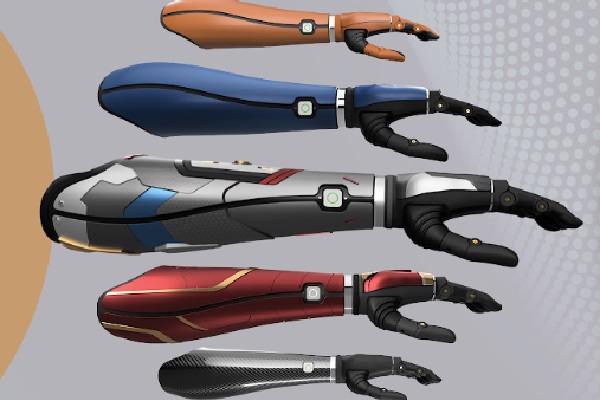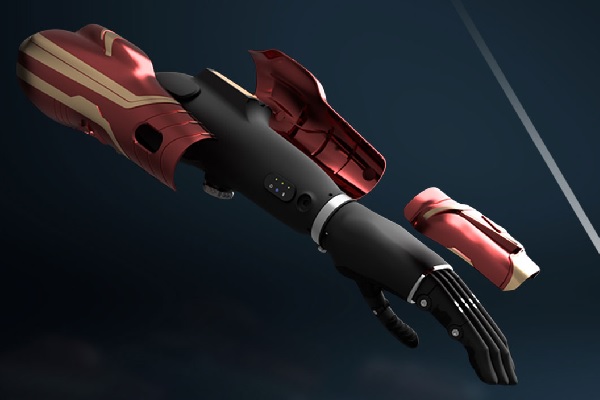KalArm is an affordable, lightweight, 3D-printed bionic hand that has the look of a serious competitor in the bionic hand marketplace.
What’s On This Page?
- A Quick Look at the KalArm
- Grip Patterns & Control System
- Thumb Rotation
- Proportional Control
- Auto-Grip
- Sensory Feedback
- Wrist Design
- Size & Weight
- Lift Capacity & Grip Strength
- Durability
- Water and Dust Resistance
- Glove Options
- Batteries
- User Software
- Suitability for Above-the-Elbow Solutions
- Suitability for Children
- Price
- Availability
- Warranty
- User Feedback Survey & Results
- Considerations Before Buying a KalArm
- Related Information
A Quick Look at the KalArm
The following video provides a good close-up view of the KalArm and a brief description of some of its key features
This next video shows the KalArm in action.
As you can see from this video, KalArm’s main focus is on helping users perform daily activities. It is not intended for use in extreme conditions (i.e. heavy-duty work, submerging in water, etc.) but rather for everyday use at an affordable price. It also happens to be extremely stylish!
The following sections describe KalArm’s features in more detail.
Key Features
Grip Patterns & Control System
KalArm offers a standard 2-channel myoelectric control system. To understand more about how these types of systems work, please see Bionic Arm & Hand Control Systems.
In the case of KalArm, it offers 18 pre-defined grips (hook, pinch, tripod, etc.) grouped into 3 standard modes of 6 grips each. Users can also create up to 6 custom grips in 1 custom mode.
To switch between grips, users typically select a mode based on their current activities, such as working in the kitchen. They do this by pressing a button. Once in a mode, users can rotate through the grips in that mode by using either a single-close or double-open signal.
Note that most users use only a few grips in a normal day, so switching grips is less frequent than it might sound.
Thumb Rotation
KalArm’s thumb can be manually adjusted to occupy one of two possible positions: opposed to index and middle fingers (e.g. a pinch grip) or unopposed, meaning it essentially gets out of the way of the fingers.
The thumb is moved into these positions simply by applying directional pressure. KalArm has a sensor to detect the thumb’s position so that it knows which grips it can perform.
Proportional Control
Proportional control means that the speed and force of a bionic hand’s finger movements are in proportion to the strength of the muscle signal generated by the user. This allows the user to vary the hand’s speed/strength depending on the nature of the object he is trying to grasp, much as one does with a natural hand.
KalArm does offer this feature.
Auto-Grip
KalArm does not offer auto-grip or automatic anti-slip technology. But it does allow the user to lock a grip in place by pressing a button. This causes KalArm to ignore accidental triggers such as open/close signals.
Sensory Feedback
KalArm does not currently offer any sensory feedback.
Wrist Design
KalArm’s wrist can be manually rotated up to 180 degrees. The user typically performs this rotation with his or her other hand.
Size & Weight
KalArm currently comes in one unisex size. Its weight is roughly 450 grams.
Lift Capacity & Grip Strength
KalArm can carry up to eight kilograms. This is equivalent to a grip force of roughly 78 Newtons.
By comparison, the average maximum grip force for women is 292 Newtons, and, for men, 517 Newtons. The average grip force used in daily activities is 70 Newtons.
Durability
We rely mostly on feedback from our User Satisfaction Survey as our main measure of durability. However, KalArm is new to us (and therefore to our audience), so it may be a year or two before we have sufficient feedback to publish this information.
In the absence of this feedback, we rely on warranty information, which you can see in its own section below.
Water and Dust Resistance
KalArm without a glove has an IP rating of 20. This means that it is not protected from liquids and is only protected from particles greater than 12mm. Put another way, KalArm should not be used in wet or dirty environments without a glove.
Glove Options
KalArm comes with a glove to protect it from water and dirt. Gloves come in multiple colors and skin tones.
KalArm’s main appearance is dictated by its use of modular panels to form its outer shell. Here are a few examples of some of the standard designs:

Makers Hive plans to release fully customizable panels within the next year. This type of personalized expression is increasingly recognized as an important feature for many bionic hand users.
Batteries
KalArm is powered by a lithium-ion battery. The battery can last one full day depending on usage. Users can select from two available options: 1100mAh and 2850mAh. Users who want the hand to look sleek can go with 1100mAh and users who want more run time can go with 2850mAh. Once completely drained, the time required to fully recharge the battery is 2 hrs for the 1100mAh and 3.5 hrs for the 2850mAh.
User Software
KalArm comes with an app named KalAssist, which can be used to:
- test grips;
- check device health;
- check grip accuracy;
- create custom grips; and
- update device firmware.
Here are a couple of screenshots from this slick-looking application:

Suitability for Above-the-Elbow Solutions
As a component hand, KalArm does qualify for participation in above-the-elbow solutions. However, it has not yet been tested for compatibility with any bionic elbows.
Suitability for Children
KalArm is currently designed only for those 15 and above due to its one unisex hand size. However, Makers Hive is working on a KalArm Mini for children.
Price
KalArm sells for less than $5,000 US in India for a complete solution.
We anticipate that it will fall into our $10,000 to $20,000 US price range when sold in the U.S.
For a complete list of prices for other bionic hands, please see our Bionic Hand Price List.
Availability
KalArm is currently available only in India. However, Makers Hive does plan to eventually launch KalArm in Europe and the U.S.
Warranty
Makers Hive offers a two-year manufacturing warranty for the KalArm.
The batter and charger come with a one-year warranty.
There do not appear to be any extended warranty options at this time.
User Feedback Survey & Results
Survey
Are you currently using a KalArm or have you used it in the past?
If so, why not help others by sharing your experiences in this quick survey:
Results
We do not yet have a sufficient number of survey participants to publish fair and accurate results for the KalArm. As soon as we do, we’ll update this section.
Considerations Before Buying a KalArm
We are always cautious about bionic limbs that are relatively new to the market simply because they have not yet established a public track record among users. In particular, we do not yet have enough responses to our User Satisfaction Survey on the KalArm to render any kind of informed opinion, and probably won’t have sufficient data to do so for another year or two.
That having been said, the company behind KalArm — Makers Hive — is not your typical startup. They have already secured significant funding and created a team of nearly 30 people with a good mix of youth, experience, and technology skills. And they seem to be doing a good job of executing a very focused plan, witness the KalArm’s highly polished appearance.
Makers Hive also claims that KalArm has been tested with users from different genders, age groups, and amputation levels to determine its ease of use. Most of the users found KalArm to be easy to use, comfortable, and very useful for daily life activities. All of these tests were performed under the supervision of a Clinical Prosthetist and Orthotist.
If you are in India, the KalArm’s incredible affordability may be too compelling to ignore. At less than $5,000 US for a complete solution, it is only one of two such devices that are attainable by the average person in India (the other being Grippy) after subsidies are taken into account.
Related Information
For a list of competitor devices, see current options for bionic hands.
For a comprehensive description of all current upper-limb technologies, devices, and research, see our complete guide.
Click here for more information on Makers Hive.
